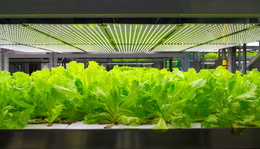LED (light-emitting diode) lights are popular artificial lighting systems used in hydroponic or soilless gardening. Some of their advantages include better growth of plants, less heat production, and low maintenance cost. This article further enlists more of their benefits.

Hydroponic gardening or soilless gardening can be defined as growing plants in nutrient solutions, rather than using soil as a growth medium. At times, inert media such as gravel, perlite, or rockwool is also used. Usually, hydroponics is practiced as indoor gardening. The necessary plant growth factors like temperature, light, and humidity are maintained in controlled conditions, so as to promote the growth and development of plants.
For better efficiency, artificial lighting systems called grow lights are used to supplement the scarcity of sunlight. These grow lights emit electromagnetic spectrum similar to the sunrays, which enhances the photosynthesis capability of the plants. Previously, metal halide and high pressure sodium lamps were used for the same. Though these grow lights provide an ideal light spectrum for the plant growth, they generate excess heat and consume large amounts of electricity and were very expensive to maintain. A more energy efficient alternative is the LED (light-emitting diode) grow light.
One of their major benefits is low cost of maintenance. Their main aim is to emit only the color spectrum required for the plant's photosynthesis. Hence, they consume less amount of electricity in comparison to the traditional lighting system and other grow lights. On an average, they consume less than 5 watts of power for operation.
The wide-spectrum red light and narrow-spectrum blue light of specific wavelengths are configured in a particular manner. The red spectrum supplements natural sunrays, whereas the blue spectrum makes an ideal light for the plant's growth. Thus, these lights provide ideal light conditions for the better growth of all types of plants and/or crops. In addition, this setting contains no toxic mercury, which is used in fluorescent lights and metallic vapor.
There are several models of LED lights, each suitable for various types of plants and their successive stages. For example, some are designed for vegetative growth, whereas some are specially configured to promote flowering and/or blooming. These lights should be hanged or mounted in hydroponic gardens, as per the manufacturer's guidelines. While using them, the height should be maintained in such a way that it covers maximum plantation area.
Another advantage is less production of heat. With minimum heat production, water requirement also reduces due to less evaporation. The problem of high temperature root damage and plant dehydration is thus solved with their use, which further eliminates the need to install fans or cooling ducts.
As these grow lights are available readily with plugs, no ballast is required for their initiation and regulation. Thus, there is no problem for ballast burning and/or replacement, which is so in case of fluorescent bulbs. These lights are long-lasting, a superior quality may last for 10-12 years.






 Hydroponic gardening or soilless gardening can be defined as growing plants in nutrient solutions, rather than using soil as a growth medium. At times, inert media such as gravel, perlite, or rockwool is also used. Usually, hydroponics is practiced as indoor gardening. The necessary plant growth factors like temperature, light, and humidity are maintained in controlled conditions, so as to promote the growth and development of plants.
Hydroponic gardening or soilless gardening can be defined as growing plants in nutrient solutions, rather than using soil as a growth medium. At times, inert media such as gravel, perlite, or rockwool is also used. Usually, hydroponics is practiced as indoor gardening. The necessary plant growth factors like temperature, light, and humidity are maintained in controlled conditions, so as to promote the growth and development of plants.